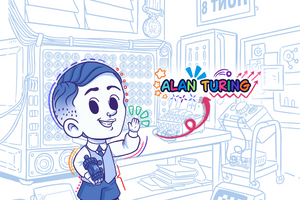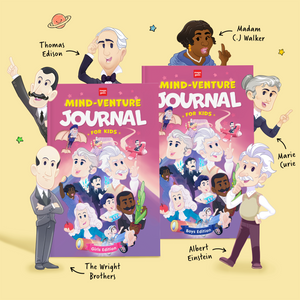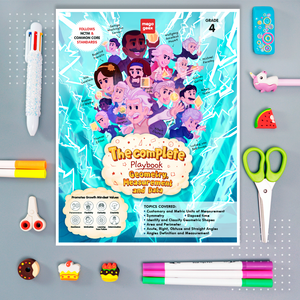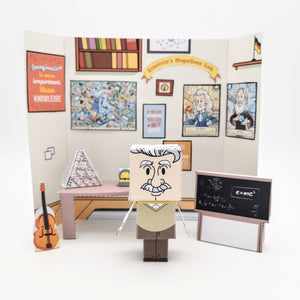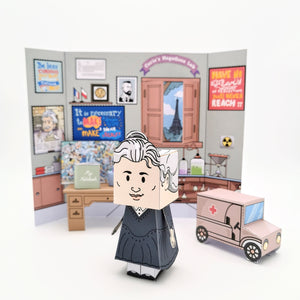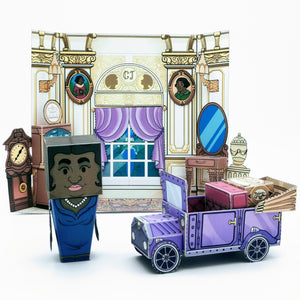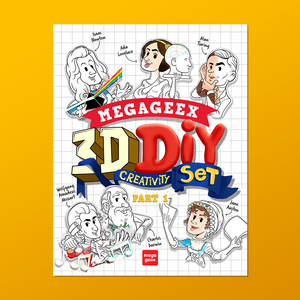The Amazing Story of Alan Turing for Kids: the Father of Computer Science
Imagine a world where computers didn't exist, and secret codes needed to be cracked to save the world. Now, imagine a young boy who was destined to change the course of history with his extraordinary intelligence. Let's step back in time and explore the life of Alan Turing, a genius who became the "Father of Computer Science" and a hero during World War II. Are you ready to embark on this exciting adventure?
-
Born: June 23, 1912
-
Died: June 7, 1954
-
Nationality: British
-
Education: Sherborne School, King's College (Cambridge), Princeton University
-
Occupation: Mathematician, Computer Scientist, Cryptanalyst
-
Best Known for: Cracking the Enigma code during WWII, Turing Machine, and founding the field of artificial intelligence
The Early Life of a Genius: Alan Turing's Childhood Years
In the charming neighborhood of Maida Vale, London, a future genius arrived into the world on June 23, 1912. This extraordinary boy, Alan Mathison Turing, was the son of Julius Mathison Turing, a member of the Indian Civil Service, and Ethel Sara, the daughter of a British Empire engineer. As the younger of two siblings, Alan grew up with his older brother, John, who shared the family's passion for knowledge and discovery.
Turing showed signs of being a genius from a very young age. When he was just a little boy, he could solve advanced math problems in his head, even before he learned how to do math on paper. His parents and teachers noticed Turing's natural inclination for math and science, and they encouraged him to explore these subjects more.
When Turing was a teenager, he attended the Sherborne School, an all-boys boarding school in Dorset, England. It was here that he met a boy named Christopher Morcom, who became his best friend. Christopher was also interested in math and science, and the two boys spent hours talking about their favorite subjects, working on projects, and even building their own radio together.
Christopher was very important in Turing's life. He inspired Alan to work harder and dream bigger. Sadly, Christopher passed away suddenly when they were both just 18 years old. This loss deeply affected Turing, but he decided to carry on and continue learning in honor of his friend.
In these early years, young Alan Turing was already showing the world his incredible talent and passion for learning. The story of his life was just beginning, and there were many more amazing things to come. Little did he know, one day he would be known as the "Father of Computer Science" and a hero who helped save the world during World War II.
From King's College to Princeton University: Turing's Academic Adventures
After finishing school, Alan Turing was ready for new adventures. He went to study at King's College, Cambridge, one of the most famous universities in the world. There, he focused on math and logic, solving complex problems and making friends with other smart students.
During his time at Cambridge, Alan Turing encountered a challenging problem in the field of mathematical biology. He was fascinated by the patterns that could be found in the natural world, like the spirals in seashells and the spots on a leopard's fur. Alan worked hard to understand these patterns, and he developed a new way to explain them using math. His ideas helped scientists better understand the world around us.
Alan Turing's talents didn't go unnoticed. In 1936, he was invited to study at another famous university, Princeton University in the United States. There, he met some of the most brilliant minds in the world, like mathematician John von Neumann.
At Princeton, Alan Turing worked on his idea for a "universal computing machine." This machine could perform any task, as long as it could be described using mathematical rules. Alan's concept laid the foundation for modern computers and changed the way we think about technology.
While at Princeton, Turing also wrote a paper about "computing machinery and intelligence." He discussed the idea of artificial intelligence, which is the study of how to create machines that can think and learn like humans. This was a groundbreaking idea at the time and is still an important topic in computer science today.
Alan Turing's academic adventures at King's College and Princeton University shaped his brilliant mind and set the stage for his future contributions to the world. From mathematical biology to the invention of the universal computing machine, Turing was already making a significant impact on the world of science and technology.
World War II: Alan Turing, the Secret Code-Breaking Hero
In 1939, when World War II began, Alan Turing was recruited to work at a top-secret place called Bletchley Park in England. His mission? To help the British government crack the secret codes used by the German army. These codes were sent through a machine called the Enigma, which changed the messages into a series of scrambled letters. The Germans believed their codes were unbreakable, but they didn't know about Alan Turing and his team of codebreakers!
Cracking the Enigma Code: German Naval Enigma
One of the most important codes Alan Turing worked on was the German Naval Enigma. This code was used by the German navy to send secret messages about their ships and submarines. If the British could break this code, they could know where the German ships were and what they were planning to do.
Alan Turing and his team faced a huge challenge as the Enigma machine had millions of possible settings, and the Germans changed the settings every day. Turing had to find a way to break the code quickly and efficiently.
Turing's Electromechanical Machine Called "The Bombe"
To help crack the Enigma code, Turing designed a special electromechanical machine called "the Bombe." This machine could test thousands of possible Enigma settings in a short amount of time. With the help of the Bombe, Turing and his team were able to break the German Naval Enigma code and read the secret messages. This was a major victory for the British and their allies!
Alan Turing's work at Bletchley Park was crucial to the success of the Allied forces during World War II. By breaking the Enigma code, Turing and his team helped the British navy sink enemy ships, protect supply convoys, and save countless lives. Some historians even believe that Turing's codebreaking efforts shortened the war by about two years!
Turing's work at Bletchley Park remained a secret for many years after the war. It wasn't until the 1970s that the public learned about his heroic efforts. Today, Alan Turing is remembered not only as a brilliant mathematician and computer scientist but also as a war hero who helped save the world from the evils of the German army.
During the second world war, Alan Turing showed the world that intelligence and determination could help win battles and save lives. His incredible skills in mathematics and codebreaking made a huge difference in the outcome of the war. Alan Turing's story reminds us that even in the darkest times, there are heroes working behind the scenes to make the world a better place.
The Birth of the Turing Machine: A Revolution in Computer Science
While working on his studies at Princeton University, Alan Turing came up with an incredible idea that would change the world of technology forever. He proposed a theoretical machine called the Universal Computing Machine, also known as the Turing Machine. This machine could read and follow instructions written on a long strip of paper, solving problems and performing tasks based on the information it received.
The Turing Machine was a groundbreaking idea because it showed that a single machine could perform any task, as long as it could be described using a set of rules or instructions. This concept is the basis of modern computer science and has had a huge impact on the way we think about technology today.
Automatic Computing Engine and Its Impact on Modern Computers
After World War II, Alan Turing continued to work on his ideas about computing. He started working at the National Physical Laboratory, where he developed the design for the Automatic Computing Engine (ACE). The ACE was a revolutionary machine that could perform many different tasks quickly and efficiently, without needing to be reprogrammed every time.
The ACE was never fully built during Turing's lifetime, but its design influenced the development of early computers around the world. Many of the features of the ACE can be found in modern computers, such as the ability to store and process data, perform calculations, and communicate with other machines.
After the War: Turing Continued to Change the World
In 1948, After World War II, Turing joined the University of Manchester and worked in mathematical biology. His most famous work in this field explained how patterns, like stripes on a zebra or spots on a leopard, form as an animal develops. This showed how math could help us understand living organisms and their behaviors.
Alan Turing and Artificial Intelligence: Can Machines Think for themselves?
But Turing didn't just invent the idea of the Turing Machine, help design the ACE and advance mathematical biology; he also laid the groundwork for the field of artificial intelligence (AI). He believed that one day, machines would be able to think and learn just like humans.
To test this idea, he created the Turing Test which works like this: a human judge has a conversation with a computer and a person through a messaging system. If the judge cannot tell which one is the computer, then the machine has "passed" the test and can be considered intelligent. Even though no machine has fully passed the test yet, his ideas have inspired many scientists to work on AI.
Today, we can see AI in many parts of our lives, from talking to virtual assistants like Siri, Alexa, and ChatGPT, to robots that perform complex tasks. These machines are always learning, getting closer to passing the Turing Test and achieving true intelligence.
Alan Turing's Legacy: A Journey Through Genius and Struggle
While Alan Turing's brilliant mind continued to make groundbreaking discoveries, his personal life faced significant challenges. In the early 1950s, Turing was arrested and charged with gross indecency due to his relationship with another man, Arnold Murray. At the time, homosexuality was illegal in the United Kingdom.
At the age of 41, Alan Turing's life came to a sudden and tragic end in 1954. The cause of death was determined to be cyanide poisoning but the circumstances surrounding Turing's death have been the subject of much speculation and debate. Some believe that his death was an accident, while others think it was a deliberate act in response to the challenges and injustices he faced. Regardless of the details, the loss of Alan Turing was a tragedy that cut short the life of a brilliant and inspiring scientist.
After Alan Turing died and in the years since his death, there have been numerous efforts to honor his memory and recognize his achievements. In 2013, Turing was granted a posthumous royal pardon, which officially acknowledged the injustice he faced and cleared his name.
Today, the Turing Award, sometimes called the "Nobel Prize of Computer Science," is awarded annually to individuals who have made significant contributions to the field. This prestigious award serves as a testament to Turing's lasting impact on the world of computer science and a reminder of the brilliant mind that was taken from us too soon.
As we reflect on the mysterious end of Alan Turing's life, we can also celebrate his incredible achievements and the lasting impact he has had on the world. Alan Turing's story is a powerful reminder of the importance of perseverance, acceptance, and the limitless potential of the human mind.
5 Fun Facts About Alan Turing for Kids to Discover!
-
Alan Turing's colleagues at Bletchley Park, where he worked during World War II, gave him the nickname 'Prof' due to his exceptional intellect and innovative codebreaking techniques.
-
Turing was a talented athlete and almost qualified for the British Olympic team in 1948 in the sport of distance running, but ultimately did not participate due to an injury.
-
Alan loved playing chess and even proposed a theoretical concept for a chess-playing machine called the "Turochamp". This algorithm was an early attempt to devise a strategy for a computer to play chess, based on decision trees and game theory. While the algorithm was never implemented as a program during Turing's lifetime, it was an important contribution to the field of artificial intelligence and the development of chess-playing computer programs.
-
Turing was awarded the Order of the British Empire (OBE) in 1945 for his work during the war.
-
He was known for his eccentric behavior, such as chaining his tea mug to a radiator to prevent it from being stolen by his colleagues.
Alan Turing for Kids: Frequently Asked Questions (FAQ)
Get answers to common questions regarding the life, professional contributions, and lasting impact of the acclaimed scientist Alan Turing.
What was Alan Turing famous for?
Alan Turing was famous for being a brilliant mathematician and computer scientist. He played a key role in breaking enemy codes during World War II, which helped the Allies win the war. Turing devised the concept of the modern computer and created the Turing Test, which is used to determine if a machine can think like a human.
Was Alan Turing a child prodigy?
Yes, Alan Turing was a child prodigy. He showed a great talent for mathematics and problem-solving from a very young age. His skills only grew stronger as he got older, eventually leading him to make groundbreaking discoveries in the world of computers and artificial intelligence.
How long did it take Alan Turing to break Enigma?
It took Alan Turing and his team of codebreakers at Bletchley Park about two years to break the Enigma code, which was used by the German military during World War II. Their work greatly shortened the war and saved many lives.
What is Alan Turing's IQ?
Alan Turing's exact IQ is not known, but he was undoubtedly a genius. His extraordinary mathematical and problem-solving abilities helped him create innovations that changed the world of computers and artificial intelligence forever.
Did Alan Turing save the world?
Although it's difficult to say if Alan Turing "saved the world," his work in breaking the Enigma code had a huge impact on World War II. By deciphering the enemy's secret messages, Turing and his team helped the Allies win the war, which ultimately preserved freedom and democracy for many countries.
Did Alan Turing know Einstein?
There is no evidence that Alan Turing personally knew Albert Einstein. While they both made significant contributions to science and mathematics, their fields of expertise were different, and they worked in separate countries during their lifetimes.
What is the Turing Test?
The Turing Test is a way to measure a machine's ability to think like a human. Alan Turing proposed the test in 1950 as a way to determine if a machine can demonstrate human-like intelligence. If a person cannot tell whether they are communicating with a human or a machine, then the machine is considered to have passed the test, showing that it can think and respond like a human.

